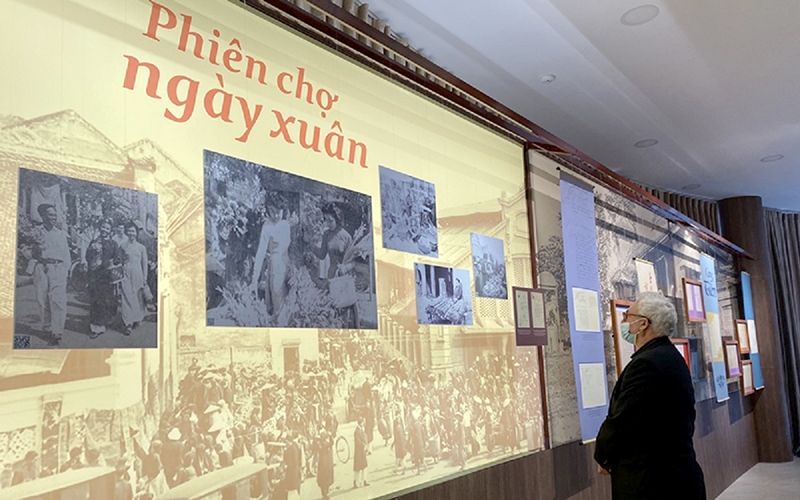Documentary heritage is historical evidence of outstanding value, containing information about the past with diverse, unique and irreplaceable content with far-reaching influence. However, to promote and spread these treasured values, it is necessary to have a journey of "waking up", opening the way for the documentary heritage to have the opportunity to get closer to the public.

A corner of the exhibition space of the documentary heritage titled "Tet Xua" (Old Tet) organised by the National Archives Centre No.1. (Photo Vy Vy)
Over the past 10 years, the term "documentary heritage" has been mentioned a lot and has gradually become familiar to the public, even though the heritage has been formed along with the flow of thousands of years of history.
The timeline for the value of documentary heritage to go beyond the narrow sphere of academia and research, and start getting closer to the public was 2009 when a host of documentary heritage was honoured by UNESCO's Memory of the World Programme.
These are three world documentary heritages including the moc ban (wood blocks), and ‘chau ban’ (royal administrative documents stamped with the Kings’ seals) under the Nguyen dynasty, and the 82 stone steles preserved in Van Mieu – Quoc Tu Giam. Four documentary heritages in the Asia-Pacific region including the woodblocks printed with Buddhist scriptures at Vinh Nghiem pagoda, the royal literature on Hue royal architecture, the Phuc Giang School's woodblocks and "Hoang Hoa su trinh do” (The Envoy’s Journey to China - literally translated as maps and itinerary of the envoy’s journey to China).
Experiencing the ups and downs of time and historical upheavals, many blocks of documentary heritage have not been left intact. But what has survived to this day is an invaluable asset that reflects the country's and nation's creative achievements over different periods, as well as important evidence affirming the national sovereignty and territorial integrity.
The values of documentary heritage must be preserved and promoted to educate historical traditions, foster the patriotic spirit and nurture national pride for present and future generations. Therefore, besides technical measures such as restoring, preserving, and digitising data to prolong the life of documents, it is important to "breathe life" into the heritage, so that the documentary heritage can tell its own stories in a vivid and close way, conquering many public audiences. And this is not an easy journey.
Master Nguyen Thu Hoai, Deputy Director of the National Archives Centre No.1 - where they’re preserving the documentary heritage of the Nguyen Dynasty manuscripts, said that: To access the types of natural cultural heritage or intangible cultural heritages such as Ca Tru, Xoan singing, Southern Don Ca Tai Tu (traditional musical art form of the south) and Hue royal court music, the public can directly visit and enjoy.
But getting access to the original documentary heritage is not so easy, because these are mainly informational documents, recorded on media such as paper, wood, audiotape, video recordings, and images are all carefully preserved in the archives. The information is formed from a long history, and is mostly written in Han-Nom (Sino-Nom) script, so not many people can understand it. Therefore, for people to enjoy the values of documentary heritage, it is necessary to have certain measures.
To attract a large audience, it is also necessary to diversify the approach through the implementation of propaganda articles, and publications, especially exhibitions of documentary heritage. This process requires a strong handshake between archivists and historians, cultural researchers and technology experts.
Following the exhibitions on documentary heritage carried out in recent years, it can be seen that the arid archival information has stepped out of the documentary concept to appear close, true and vivid.
Master Nguyen Thu Hoai shared that to "publicize" the documentary heritage, is so that many people can access and understand the material, it not only requires an in-depth research process to explore and select the documents. Outstanding content is introduced but also needs the ability to link with supporting materials from many different sources to create a chain and connect information, to convey to the public stories with their messages and themes.
The fact is that recent exhibitions on documentary heritage, due to being invested in both content and images, have attracted not only academia but also a wide range of the public, especially young people, including many visitors from countries such as the Republic of Korea, Japan, China, France and Russia.
This confirms that the information in the documentary heritage, when creatively exploited, will create a great spread. And linking data with documents, supported by technology to realise historical stories in many forms, is the direction and solution to diversify and improve the efficiency of conservation and promote the great value of Vietnam's documentary heritage.
Trang Anh - Translated by NDO